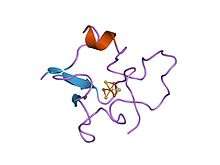High potential iron–sulfur protein
High potential iron-sulfur proteins (HIPIP)[2] are a specific class of high-redox potential 4Fe-4S ferredoxins that functions in anaerobic electron transport and which occurs in photosynthetic bacteria and in Paracoccus denitrificans. The HiPIPs are small proteins which show significant variation in their sequences, their sizes (from 63 to 85 amino acids), and in their oxidation- reduction potentials. As shown in the following schematic representation the iron-sulfur cluster is bound by four conserved cysteine residues.
[ 4Fe-4S cluster]
| | | |
xxxxxxxxxxxxxxxxxxxCxCxxxxxxxCxxxxxCxxxx
- 'C'
- conserved cysteine involved in the binding of the iron-sulfur cluster.
| High potential iron-sulfur protein | |||||||||
|---|---|---|---|---|---|---|---|---|---|
 Structure of the oxidized high-potential iron-sulfur protein.[1] | |||||||||
| Identifiers | |||||||||
| Symbol | HIPIP | ||||||||
| Pfam | PF01355 | ||||||||
| InterPro | IPR000170 | ||||||||
| PROSITE | PDOC00515 | ||||||||
| SCOPe | 1hpi / SUPFAM | ||||||||
| OPM superfamily | 116 | ||||||||
| OPM protein | 1hpi | ||||||||
| |||||||||
[Fe4S4] clusters
The [Fe4S4] clusters are abundant cofactors of metalloproteins.[3] They participate in electron-transfer sequences. The core structure for the [Fe4S4] cluster is a cube with alternating Fe and S vertices. These clusters exist in two oxidation states with a small structural change. Two families of [Fe4S4] clusters are known: the ferredoxin (Fd) family and the high-potential iron–suflur protein (HiPIP) family. Both HiPIP and Fd share the same resting state: [Fe4S4]2+, which have the same geometric and spectroscopic features. Differences arise when it comes to their active state: HiPIP forms by oxidation to [Fe4S4]3+, and Fd is formed by reduction to [Fe4S4]+.
The different oxidation states are explained by the proteins that combined with the [Fe4S4] cluster. Analysis from crystallographic data suggests that HiPIP is capable of preserving its higher oxidation state by forming fewer hydrogen bonds with water. The characteristic fold of the proteins wraps the [Fe4S4] cluster in a hydrophobic core, only being able to form about five conserved H-bond to the cluster ligands from the backbone. In contrast, the protein associated with the Fd's allows these clusters to contact solvent resulting in 8 protein H-bonding interactions. The protein binds Fd via conserved CysXXCysXXCys structure (X stands for any amino acid).[4] Also, the unique protein structure and dipolar interactions from peptide and intermolecular water contribute to shielding the [Fe4S4]3+ cluster from the attack of random outside electron donors, which protects itself from hydrolysis.
Synthetic analogues
HiPIP analogues can be synthesized by ligand exchange reactions of [Fe4S4{N(SiMe3)2}4]− with 4 equiv of thiols (HSR) as follows:
- [Fe4S4{N(SiMe3)2}4]− + 4RSH → [Fe4S4(SR)4]− + 4 HN(SiMe3)2
The precursor cluster [Fe4S4{N(SiMe3)2}4]− can be synthesized by one-pot reaction of FeCl3, NaN(SiMe3)2, and NaSH. The synthesis of HiPIP analogues can help people understand the factors that cause variety redox of HiPIP.[5]
Biochemical reactions
HiPIPs take part in many oxidizing reactions in creatures, and are especially known with photosynthetic anaerobic bacteria, such as Chromatium, and Ectothiorhodospira. HiPIPs are periplasmic proteins in photosynthetic bacteria. They play a role of electron shuttles in the cyclic electron flow between the photosynthetic reaction center and the cytochrome bc1 complex. Other oxidation reactions HiPIP involved include catalyzing Fe(II) oxidation, being electron donor to reductase and electron accepter for some thiosulfate-oxidizing enzyme.[6]
References
- Benning MM, Meyer TE, Rayment I, Holden HM (1994). "Molecular Structure of the Oxidized High-Potential Iron-Sulfur Protein Isolated from Ectothiorhodospira vacuolata". Biochemistry. 33 (9): 2476–2483. doi:10.1021/bi00175a016. PMID 8117708.
- Breiter DR, Meyer TE, Rayment I, Holden HM (1991). "The molecular structure of the high potential iron-sulfur protein isolated from Ectothiorhodospira halophila determined at 2.5-A resolution". The Journal of Biological Chemistry. 266 (28): 18660–18667. PMID 1917989.
- Jr, Perrin; T., Ichive (2013). "Identifying sequence determinants of reduction potentials of metalloproteins". Biological Inorganic Chemistry. 18 (6): 599–608. doi:10.1007/s00775-013-1004-6. PMC 3723707. PMID 23690205.
- Dey, Abhishek; Jr, Francis; Adams, Michael; Babini, Elena; Takahashi, Yasuhiro; Fukuyama, Keiichi; Hodgson, Keith; Hedman, Britt; Solomon, Edward (2007). "Solvent Tuning of Electronchemical Potentials in the Active Sites of HiPIP Versus Ferredoxin". Science. 318 (5855): 1464–1468. doi:10.1126/science.1147753. PMID 18048692.
- Ohki, Yasuhiro; Tanifuji, Kazuki; Yamada, Norihiro; Imada, Motosuke; Tajima, Tomoyuki; Tatsumi, Kazujuki (2011). "Synthetic analogues of [Fe4S4(Cys)3(His)] in hydrogenases and [Fe4S4(Cys)4] in HiPIP derived from all-ferric [Fe4S4{N(SiMe3)2}4]". Proceedings of the National Academy of Sciences of the United States of America. 108 (31): 12635–12640. doi:10.1073/pnas.1106472108. PMC 3150945. PMID 21768339.
- Valentine, Joan; Bertini, Ivano; Gray, Harry; Stiefel, Edward (2006-10-30). Biological Inorganic Chemistry: Structure and Reactivity (first ed.). ISBN 978-1891389436.
Further reading
- Nogi T, Fathir I, Kobayashi M, Nozawa T, Miki K (2000). "Crystal structures of photosynthetic reaction center and high-potential iron-sulfur protein from Thermochromatium tepidum: Thermostability and electron transfer". Proceedings of the National Academy of Sciences. 97 (25): 13561–13566. doi:10.1073/pnas.240224997. PMC 17615. PMID 11095707.